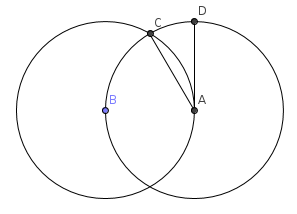What is Going on Here? Would like an answer, please!
So I was trying to derive a way to approximate using my compass and straightedge, and then use algebra. I began by creating a degree angle:

So is degrees. Then, I imagined bisecting this angle into infinity. Notice if we draw a segment from to , we get an isosceles. We can calculate for this length using the law of cosines: , where is a reiteration (another bisection). So, if I am correct in my assumption, should be about , if are the number of divisions in the circle. We can find easily enough: . we know this becuase, as we bisect, we get a table of values: . Likewise, we find thusly: . This table of values is found by dividing 360 by : . So to find , we use the law of cosine, take the square, and multiply by n. This gives me the equation: This makes sense from the way I constructed it, but not here:
This becomes: Obviously, . So, I tested with two values of that my calculator could handle. For , (correct to 11 decimal places.) However, at , (correct to only 4 decimal places.) So why does this equation get close to , as it is supposed to, and then stop, and then appear to approach zero? Thanks for the help, I am not all that great at math, and would really appreciate it!
Easy Math Editor
This discussion board is a place to discuss our Daily Challenges and the math and science related to those challenges. Explanations are more than just a solution — they should explain the steps and thinking strategies that you used to obtain the solution. Comments should further the discussion of math and science.
When posting on Brilliant:
*italics*or_italics_**bold**or__bold__paragraph 1
paragraph 2
[example link](https://brilliant.org)> This is a quote# I indented these lines # 4 spaces, and now they show # up as a code block. print "hello world"\(...\)or\[...\]to ensure proper formatting.2 \times 32^{34}a_{i-1}\frac{2}{3}\sqrt{2}\sum_{i=1}^3\sin \theta\boxed{123}Comments
Extremely interesting! How are you saying that limit is 0? (Hint: It's an indeterminate form, (0⋅∞))
The correct limit is π, just like you wanted.
Log in to reply
Well, it seemed like as r approached infinity, the cosine would approach 0. of course, cos(0) = 1 and so we would get 0∗24∗2r−2. Since the limit is π, is there something wrong with my calculations? Since the precision seemed to degrade for higher r's. Thanks, I don't have the experience of ever learning limits in school, so I do not realize there is such a thing as indeterminate forms, but I was unsure what to do with the 0∗∞ case. I just assumed for any number, you would get zero. Thanks for the help! :)
Log in to reply
Oh okay, I'll try to explain then. Suppose you had two functions, f(x) and g(x),
limx→∞f(x)=∞ and limx→∞g(x)=0. Now what is limx→∞f(x)⋅g(x)?
If you think about it, you really can't say, because it could be 0 or ∞ or some value in between.
Why? It depends on the functions f(x) and g(x) themselves.
Let me give you some examples. Let L=limx→∞f(x)⋅g(x).
So, we've seen that the limit can be anything really. This is why we call 0⋅∞ an indeterminate form, it can 'evaluate' to anything.
Now, to your question, how do we evaluate limr→∞2−2⋅cos2r30⋅24⋅2r−2?
Here, f(x)=24⋅2r−2 and g(x)=2−2⋅cos2r30 (Understand why.)
So what is L, here?
(Convert 30 to 6π radians)
L = limr→∞2−2⋅cos6⋅2rπ⋅6⋅2r
Let t=6⋅2r1.
L = limt→0t2−2⋅cosπt=limt→0t21−cosπt=limt→0t22sin22πt=limt→0t2sin2πt=π
I used the well-known facts that 1−cos2x=2sin2x and limx→0xsinx=1.
Log in to reply
Well explained.
It's a very common misconception to "Let n→∞ in a specific portion of the expression, while ignoring the rest of it".
Thanks a lot, I think I understand it now! Very clear explanation, also! +1
Log in to reply
Thanks! Also, the reason your calculator drops off in precision is because of rounding off errors and approximate values for the cosines and sines.
Log in to reply
Right, that was what I suspected, but I put a bit too much faith in the arbitrary precision calculations, I guess. xD